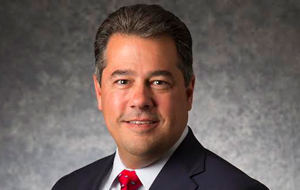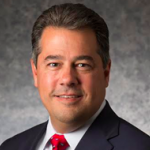Just 30 days after joining the NEC Corporation of North America, VP of IT Juan Fontanes began a complete IT systems overhaul: retiring 73 percent of the company’s legacy applications and websites while consolidating three legacy ERP systems into one new one. This modernization project saved the company millions of dollars, streamlined processes, and improved automation.
 Fontanes recently won the Corporate CIO of the Year award from the Dallas CIO Leadership Association. We asked him to share more about the digital transformation and how it changed the role of IT.
Fontanes recently won the Corporate CIO of the Year award from the Dallas CIO Leadership Association. We asked him to share more about the digital transformation and how it changed the role of IT.

The Enterprisers Project (TEP): Can you talk about your experience leading cultural change within a Japanese company? What were some challenges you faced, and how did they affect your approach to changing the role of IT from order-taker to value-added partner?
 Fontanes: Leading a cultural change in any company is tough, but within a Japanese company you really need to respect one another’s point-of-view and demonstrate that, ultimately, there are traditions around things like consensus that probably will never change completely. I think the biggest challenges we had were decision making at a faster speed than what has been done historically, given our timeline, and running more work in the remote areas of the region, versus centrally in Tokyo. Both of those were necessary in order to achieve the digital transformation.
Fontanes: Leading a cultural change in any company is tough, but within a Japanese company you really need to respect one another’s point-of-view and demonstrate that, ultimately, there are traditions around things like consensus that probably will never change completely. I think the biggest challenges we had were decision making at a faster speed than what has been done historically, given our timeline, and running more work in the remote areas of the region, versus centrally in Tokyo. Both of those were necessary in order to achieve the digital transformation.
It’s tough to transform IT from an order-taker to a value-added partner at any company. I think you have to demonstrate deep knowledge of the processes and not be afraid to suggest changes. You have to be very proactive and surface to all of your partners and teammates that areas of value may be flying under the radar. You have to say what you’re going to do and do what you say. You have to really engage, and you have to do it in a way as if you’re helping to run the P&L. If you do that a few times – and in particular deliver on schedule and learn to deal with the emergencies that come up – that’s what stops you from being an order-taker.
TEP: A big part of adding value included your efforts to modernize or retire legacy systems within NECAM IT. Can you describe what you were able to achieve and the value this modernization has brought to the business?
Fontanes: We retired 73 percent of the legacy applications, substantially improved our cybersecurity position by retiring 39 old, external legacy websites, and modernized onto a new, modern portal. Additionally, we bore the burden in the cost of operating three old legacy ERP systems. We consolidated that into a new, single modern ERP system. The cost of it is expensive, but nowhere near the cost of supporting three ERP systems.
We made other improvements internally, too, which allowed for more streamlined, automated order entry. Previously, about 50 percent of our orders were in an automated fashion, and today we’re over 85 percent. Of those, at least 90 percent are frictionless.
TEP: How do these efforts map back to the business’ overarching goals of enterprise transformation, growth, and cybersecurity? How did you make these objectives clear so those in IT felt connected to the mission of the business?
Fontanes: Our overarching goal was to move to a solutions-oriented company. Traditionally, we made hardware, put it in a box, and we shipped it to you. We certainly moved the productions through much faster, but now we allow the ability to bundle services and overall solutions on a single order with single invoicing – in a completely requisite digital way that we weren’t able to do before. The digital transformation enabled those things.
Another part of moving from a box-mover to a solutions-provider was to provide unity across NECAM. “One NECAM” was really our mantra – we wanted customers to feel like they were dealing with a single provider when they interacted with us from the outside. By eliminating three ERP systems, customers now get a seamless experience and they can order products easily across multiple product lines, which they couldn’t do before. It was pretty easy to understand what our goals were when we understood what the transformation of NECAM needed to be.
TEP: What is your approach to coaching and training, and what do you look for in IT talent to know whether someone will excel in this environment?
Fontanes: Over the years I have found that IT staffs get just as motivated about the work they’re doing, the tools they’re using, and the technology they’re working in as they do about financial compensation. My approach is to create really exciting work with the latest tools and platforms, which creates a draw instead of a push.
In terms of what we look for, we want someone who’s a bit of a risk taker, somebody who has a track record of being able to fail fast and rebound. We do annual performance evaluations and performance plans, but we coach in real time. It’s almost as if you’re running off a football field and your position coach grabs you and says, “Hey, you were really good there. But here’s how you can improve.” Or, “Hey, we worked on that last week. I’m so happy to see it’s working.”
TEP: What is an important leadership lesson you’ve learned over your career?
Fontanes: The shadow you cast is much longer than you think. It’s really incumbent upon me, every day, to try and be my best, be at the top of my game, and treat absolutely everybody with dignity and respect. If I fall down on that, I make sure I make it right and apologize. The second lesson is take time to have those little three-, four-, or five-minute conversations with your employees – in the hallway, at the water-cooler, wherever. Being accessible is important.






